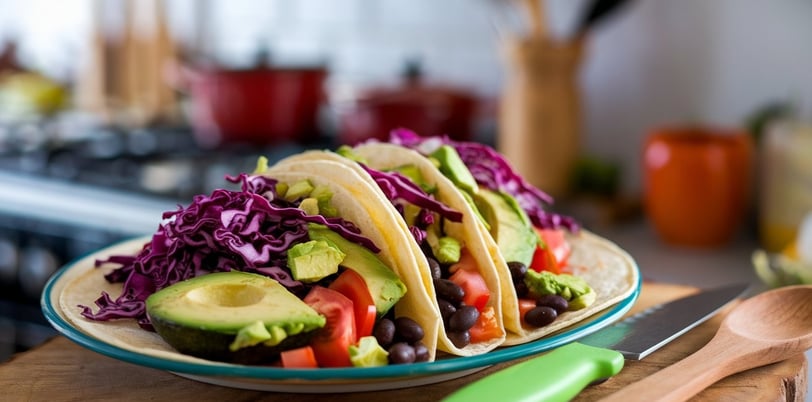Delicious Vegetable Tacos: A Step-by-Step Preparation Guide
FOOD
10/18/20245 min read


Choosing the Right Vegetables
When it comes to crafting delicious vegetable tacos, the selection of fresh and seasonal vegetables is paramount. Not only do the right vegetables contribute significantly to the flavor profile of your tacos, but they also enhance the nutritional value of the meal. Popular choices include bell peppers, zucchini, mushrooms, and corn, each offering unique flavors and textures that can elevate your dish.
Bell peppers, available in a spectrum of colors, add a sweet crunch that complements various taco fillings. Their high vitamin C content and diverse antioxidants make them a nutritious addition. When selecting bell peppers, look for ones that are firm and vibrant, avoiding any with blemishes or soft spots.
Zucchini is another excellent option, providing a mild flavor that balances well with more intense ingredients. Being low in calories yet rich in dietary fiber, zucchini can help make your tacos hearty without excessive richness. Choose small to medium-sized zucchini, as they tend to be more tender and flavorful than larger varieties.
Mushrooms, especially varieties like portobello or cremini, bring umami depth and a meaty texture to your vegetable tacos. Their rich flavor profile can be intensified through grilling or sautéing. When selecting mushrooms, ensure they are firm and free from moisture, as freshness is key in enhancing their taste.
Lastly, corn adds a burst of sweetness and a satisfying crunch, making it a popular addition in vegetable tacos. Fresh corn on the cob is preferred, but frozen corn can also serve well in a pinch. Pick ears that feel heavy and have tightly packed kernels to ensure peak freshness.
Ultimately, the careful selection and preparation of these vegetables can dramatically improve your taco experience. By focusing on freshness and seasonality, you will not only create a vibrant dish but also ensure you are getting the maximum health benefits from your ingredients.
Marinating and Seasoning for Flavor
To achieve maximum flavor in your vegetable tacos, the process of marinating and seasoning is crucial. Start by selecting fresh, high-quality vegetables such as bell peppers, zucchini, mushrooms, and onions, as these will serve as the principal components of your dish. The choice of marinade can significantly enhance the taste profiles of these vegetables, making them truly irresistible.
A simple yet effective marinade can consist of olive oil, lime juice, garlic, and your choice of herbs such as cilantro or oregano. For a spicy kick, consider adding jalapeños or crushed red pepper flakes. To cater to various dietary preferences, ensure your marinades are vegan and gluten-free. After combining the ingredients, immerse your vegetables in the mixture and allow them to marinate. A recommended marinating time is at least 30 minutes, but for optimal flavor absorption, allowing them to sit for 2 to 4 hours is ideal.
Once marinated, your vegetables can be cooked using a variety of techniques. Grilling is a popular option, as it adds a smoky flavor that pairs excellently with the marinade. When grilling, preheat the grill and ensure the vegetables are properly spaced to achieve even cooking. Alternatively, roasting your vegetables in the oven can also intensify their flavors. Preheat your oven to 400°F (200°C) and spread the marinated vegetables in a single layer on a baking sheet. Roast for 20 to 25 minutes, flipping halfway through for an even cook.
Sautéing is another technique that allows for quick preparation while locking in flavors. Heat a skillet over medium-high heat, and add the marinated vegetables, cooking for about 8 to 10 minutes until they are tender yet crisp. This method is particularly effective for onions and bell peppers, enhancing their sweetness.
Taco Assembly: Tips and Techniques
Assembling vegetable tacos is a creative and enjoyable process that allows you to play with various textures and flavors. There are primarily three types of taco shells to consider: crunchy, soft, and gluten-free options. Crunchy taco shells provide a satisfying crunch, which contrasts beautifully with the tender vegetables. Soft tortillas, often made from corn or flour, offer a pliable vessel for hugging the filling, giving a more intimate dining experience. For those with dietary restrictions, gluten-free tortillas are increasingly available, ensuring everyone can indulge in delicious tacos.
The order in which you layer your ingredients is crucial for achieving a balanced flavor profile. Start with a base layer, often a spread of refried beans or guacamole, which not only adds richness but also helps to prevent the taco shell from becoming soggy. Next, add the sautéed or roasted vegetables, ensuring they are evenly distributed to create a harmonious blend of textures. A combination of diced bell peppers, zucchini, and onions can yield a visually appealing and flavorful filling.
To elevate your vegetable tacos further, consider your toppings. Fresh avocado slices can provide creaminess, while salsa can add a burst of acidity and spice. Fresh herbs like cilantro or parsley can introduce an aromatic element, enhancing the overall experience. Additionally, crumbled queso, shredded lettuce, or a drizzle of lime juice can make for delightful finishing touches. Remember to balance flavors by including sweet, spicy, crunch, and creaminess in each bite.
Incorporating these taco assembly techniques ensures that every bite is filled with an exciting combination of flavors and textures. With practice, you will discover your preferred arrangements, creating vegetable tacos that are both delicious and visually stunning. The art of taco assembly lies not only in the ingredients but also in the thoughtful consideration of how each element interacts within the tortilla.
Serving Suggestions and Pairings
Vegetable tacos are not only delicious but also versatile, making them a great option for various occasions. To enhance the flavors of vegetable tacos, consider pairing them with sides that complement the fresh ingredients. A refreshing corn salad with lime dressing offers a vibrant contrast, while guacamole adds creaminess that balances the crunch of the tacos. Additionally, black beans or refried beans can provide a hearty base, ensuring a satisfying meal.
When it comes to drinks, a light beer or a crisp white wine, such as Sauvignon Blanc, can elevate the dining experience. For a non-alcoholic option, fizzy mineral water with a splash of lime or fresh fruit juices, such as mango or pineapple, can add a tropical touch. These beverages compliment the fresh flavors of the vegetable fillings while providing a refreshing counterpoint.
Salsas play a crucial role in enhancing the flavor profile of vegetable tacos. A classic pico de gallo with diced tomatoes, onions, cilantro, and jalapeños adds a fresh kick, while a mango salsa can incorporate sweetness that contrasts beautifully with the savory elements. A smoky chipotle sauce can also be employed for those wishing to add depth and heat to their tacos.
Presentation is key for any meal. Serve the vegetable tacos on colorful plates, topped with fresh herbs, lime wedges, and interesting garnishes like radish slices for an eye-catching display. Hosting a taco night can be a fun gathering experience; create a taco bar where guests can personalize their fillings and toppings. This not only fosters interaction but also accommodates varying tastes.
When it comes to leftovers, store the components separately to maintain their freshness. Leftover tacos can easily be reinvented by chopping up the filling and tossing it into a salad or serving it over rice. Enjoying vegetable tacos in different forms can transform a simple meal into an exciting culinary experience.
Wellness
Explore beauty tips and holistic health insights
contact us
Balance
sapwans2005@gmail.com
© 2024. All rights reserved.
